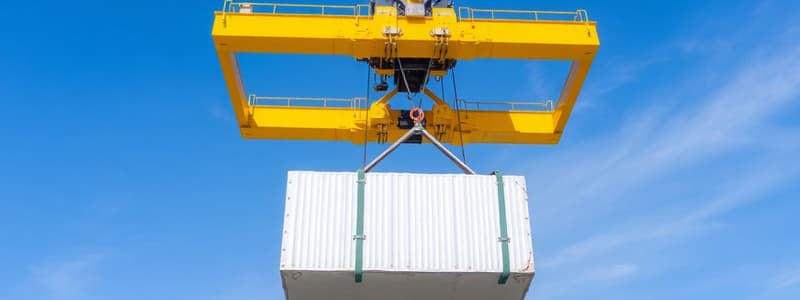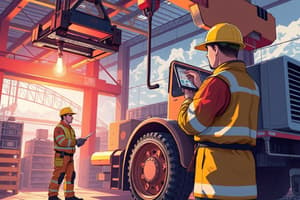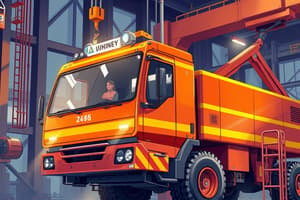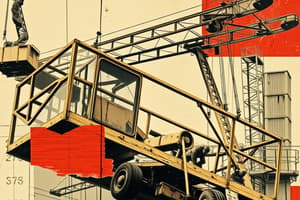Podcast
Questions and Answers
What is defined as the specified load below which equipment does not fail by fracture or distortion?
What is defined as the specified load below which equipment does not fail by fracture or distortion?
- Minimum Breaking Load (correct)
- Single Purpose Equipment
- Rated Capacity
- Proof Load
What describes equipment that is designed to lift a variety of loads up to the marked safe working load?
What describes equipment that is designed to lift a variety of loads up to the marked safe working load?
- Proof Load
- Multipurpose Equipment (correct)
- Operative
- Single Purpose Equipment
What term describes the maximum load that a lifting appliance can lift in any given configuration?
What term describes the maximum load that a lifting appliance can lift in any given configuration?
- Minimum Breaking Load
- Proof or Test Load
- Working Load Limit
- Rated Capacity (correct)
Which document provides details about the specifics of a test performed on lifting equipment?
Which document provides details about the specifics of a test performed on lifting equipment?
What is the role of an Operative in relation to lifting equipment?
What is the role of an Operative in relation to lifting equipment?
What type of equipment is specifically designed for lifting a single type of load?
What type of equipment is specifically designed for lifting a single type of load?
What is a Proof or Test Load used for?
What is a Proof or Test Load used for?
Which of the following is NOT characteristic of Multipurpose Equipment?
Which of the following is NOT characteristic of Multipurpose Equipment?
What does SWL stand for in the context of lifting equipment?
What does SWL stand for in the context of lifting equipment?
Which term refers to the maximum load that lifting equipment is designed to raise under ideal conditions?
Which term refers to the maximum load that lifting equipment is designed to raise under ideal conditions?
What is a common misconception about the terms SWL and WLL?
What is a common misconception about the terms SWL and WLL?
What markings are generally required on lifting equipment?
What markings are generally required on lifting equipment?
In areas where 'safe' is not used, what term is commonly substituted?
In areas where 'safe' is not used, what term is commonly substituted?
What must be assessed by a Competent Person regarding lifting equipment?
What must be assessed by a Competent Person regarding lifting equipment?
Which statement correctly differentiates working load limit from safe working load?
Which statement correctly differentiates working load limit from safe working load?
Which of the following describes 'rated capacity'?
Which of the following describes 'rated capacity'?
What is the first priority for controlling significant health risks?
What is the first priority for controlling significant health risks?
Which of the following is NOT part of the hierarchy of control measures?
Which of the following is NOT part of the hierarchy of control measures?
What does 'PPE' stand for within the context of control measures?
What does 'PPE' stand for within the context of control measures?
Which control measure involves ensuring compliance with safety procedures?
Which control measure involves ensuring compliance with safety procedures?
Why is effective monitoring of safe systems important?
Why is effective monitoring of safe systems important?
What must personnel involved in a specific risk assessment receive?
What must personnel involved in a specific risk assessment receive?
The safe systems of work must be regularly...
The safe systems of work must be regularly...
Which component is crucial for lifting equipment to be suitable for its purpose?
Which component is crucial for lifting equipment to be suitable for its purpose?
What is the primary purpose of Job Safety Analysis?
What is the primary purpose of Job Safety Analysis?
During which step of the 5-step approach are you required to assess the significance of risks?
During which step of the 5-step approach are you required to assess the significance of risks?
Which step requires recording significant findings of the risk assessment?
Which step requires recording significant findings of the risk assessment?
What might necessitate a review of the findings from a Job Safety Analysis?
What might necessitate a review of the findings from a Job Safety Analysis?
Why is it important to identify significant hazards first?
Why is it important to identify significant hazards first?
Who should be considered at risk during a Job Safety Analysis?
Who should be considered at risk during a Job Safety Analysis?
What should be done after recording the findings of a Job Safety Analysis?
What should be done after recording the findings of a Job Safety Analysis?
How often should workplace conditions be reviewed for hazards?
How often should workplace conditions be reviewed for hazards?
What is the term for a mixture of metals?
What is the term for a mixture of metals?
Which type of metal typically contains a high percentage of iron?
Which type of metal typically contains a high percentage of iron?
What is the primary material used in the manufacture of lifting equipment?
What is the primary material used in the manufacture of lifting equipment?
What is usually done to make iron suitable for lifting equipment?
What is usually done to make iron suitable for lifting equipment?
How is carbon removed from iron to produce steel?
How is carbon removed from iron to produce steel?
What happens to the properties of pure iron when it is processed in a blast furnace?
What happens to the properties of pure iron when it is processed in a blast furnace?
Which of the following is a characteristic of low carbon steel?
Which of the following is a characteristic of low carbon steel?
What is produced as a result of the reaction between oxygen and carbon in molten iron?
What is produced as a result of the reaction between oxygen and carbon in molten iron?
Which type of steel is primarily used in the manufacture of lifting gear such as chains and fittings?
Which type of steel is primarily used in the manufacture of lifting gear such as chains and fittings?
What is the typical carbon content range for Higher Tensile Steel?
What is the typical carbon content range for Higher Tensile Steel?
What is a disadvantage of alloy steels compared to carbon steels?
What is a disadvantage of alloy steels compared to carbon steels?
Which of the following is NOT commonly added to alloys to improve physical properties?
Which of the following is NOT commonly added to alloys to improve physical properties?
Why are alloys typically harder than pure metals?
Why are alloys typically harder than pure metals?
What is one application of copper in lifting equipment?
What is one application of copper in lifting equipment?
Which characteristic of high carbon steel limits its use in certain applications?
Which characteristic of high carbon steel limits its use in certain applications?
What is the primary use of mild steel?
What is the primary use of mild steel?
Flashcards
Minimum Breaking Load
Minimum Breaking Load
The load below which the equipment does not fail by fracture or distortion.
Multipurpose Equipment
Multipurpose Equipment
Equipment designed to lift various loads, not specific to one application.
Operative
Operative
A trained person who uses lifting equipment safely and effectively.
Rated Capacity
Rated Capacity
Signup and view all the flashcards
Proof or Test Load
Proof or Test Load
Signup and view all the flashcards
Single Purpose Equipment
Single Purpose Equipment
Signup and view all the flashcards
Report of Test
Report of Test
Signup and view all the flashcards
Working Load Limit (WLL)
Working Load Limit (WLL)
Signup and view all the flashcards
Thorough Examination
Thorough Examination
Signup and view all the flashcards
Proof Load Test
Proof Load Test
Signup and view all the flashcards
Safe Working Load (SWL)
Safe Working Load (SWL)
Signup and view all the flashcards
Maximum SWL
Maximum SWL
Signup and view all the flashcards
Lifting Accessories
Lifting Accessories
Signup and view all the flashcards
Competent Person
Competent Person
Signup and view all the flashcards
Job Safety Analysis
Job Safety Analysis
Signup and view all the flashcards
Identify the Hazards
Identify the Hazards
Signup and view all the flashcards
Who Might Be Harmed
Who Might Be Harmed
Signup and view all the flashcards
Evaluate the Risks
Evaluate the Risks
Signup and view all the flashcards
Record Your Findings
Record Your Findings
Signup and view all the flashcards
Implement Precautions
Implement Precautions
Signup and view all the flashcards
Review Your Findings
Review Your Findings
Signup and view all the flashcards
Continuous Vigilance
Continuous Vigilance
Signup and view all the flashcards
Hierarchy of Control Measures
Hierarchy of Control Measures
Signup and view all the flashcards
Eliminate
Eliminate
Signup and view all the flashcards
Reduce
Reduce
Signup and view all the flashcards
Isolate
Isolate
Signup and view all the flashcards
Control Measures
Control Measures
Signup and view all the flashcards
PPE
PPE
Signup and view all the flashcards
Monitor and Review
Monitor and Review
Signup and view all the flashcards
Training and Supervision
Training and Supervision
Signup and view all the flashcards
Low Carbon Steel
Low Carbon Steel
Signup and view all the flashcards
Medium Carbon Steel
Medium Carbon Steel
Signup and view all the flashcards
High Carbon Steel
High Carbon Steel
Signup and view all the flashcards
Alloy Steel
Alloy Steel
Signup and view all the flashcards
Properties of Alloy Steel
Properties of Alloy Steel
Signup and view all the flashcards
Copper Alloys
Copper Alloys
Signup and view all the flashcards
Tensile Strength
Tensile Strength
Signup and view all the flashcards
High Tensile Steel
High Tensile Steel
Signup and view all the flashcards
Metals
Metals
Signup and view all the flashcards
Alloy
Alloy
Signup and view all the flashcards
Ferrous Metals
Ferrous Metals
Signup and view all the flashcards
Non-Ferrous Metals
Non-Ferrous Metals
Signup and view all the flashcards
Pure Iron
Pure Iron
Signup and view all the flashcards
Blast Furnace Iron
Blast Furnace Iron
Signup and view all the flashcards
Steel Production
Steel Production
Signup and view all the flashcards
Study Notes
Industry Relevant Definitions
- Minimum Breaking (or Failure) Load: The specified load (mass or force) below which the equipment does not fail, either by fracture or distortion causing load release.
- Multipurpose Equipment: Designed to a standard specification, capable of lifting various loads up to the marked safe working load (SWL), suited for multiple applications.
- Operative: Trained person operating the equipment.
- Rated Capacity: Maximum gross load the lifting appliance can lift in any configuration, often used interchangeably with working load limit for lifting accessories.
- Proof or Test Load: A load (mass or force) applied by a Competent Person to test the equipment. This load is recorded on examination reports and test certificates. Proof load tests verify new equipment and post-installation functionality.
- Single Purpose Equipment: Designed for a dedicated purpose; used for a specific load in a specific environment.
- Report of Test: (Formerly "test certificate") A report by a competent person detailing test specifics; not a legal document for use authorization unless supporting documents, such as EC Declarations of Conformity or Manufacturers Certificates, are also involved.
Verification
- Verification: Description of procedures manufacturers or competent people undertake to guarantee the equipment meets legal requirements and operation safety standards. It includes proof load tests, sample breaks, non-destructive tests, calculations, measurements, and thorough examinations to confirm compliance with standards and specifications. Verification methods vary by new equipment standards.
Report of a Thorough Examination
- A thorough examination report, also known as a report of thorough inspection or periodic inspection, records results of a thorough examination undertaken by a competent person (including testing if applicable). The report details reported defects or states fitness for continued use. Thorough examination reports are important recordkeeping documents. References to test reports can be included as appendices to thorough examination reports in some instances.
Safe (Specific application) Working Load (SWL)
- Safe Working Load (SWL): The maximum load (mass) a competent person assesses for lifting equipment in specific service conditions. It's marked on the equipment and included in official records. In some areas, "safe" is not used; instead, the term "specific application" is used, with SWL used throughout the document. The SWL is often the same value as the working load limit (WLL), maximum safe working load, or rated capacity.
WLL (Working Load Limit)
- Working Load Limit (WLL): Maximum load (mass) a piece of lifting equipment is designed to lift, lower, or suspend. WLL can sometimes be referred to as maximum SWL in certain standards or documents. WLL is commonly used for lifting accessories, while lifting appliances use rated capacity more frequently now.
Risk Assessment
- Risk Assessment: A 5-step process used to control workplace hazards.
- Step 1: Identify all hazards in the workplace.
- Step 2: Determine who might be harmed and how.
- Step 3: Evaluate the risks and decide on precautions.
- Step 4: Record findings and put precautions in place for all hazards.
- Step 5: Review the findings periodically due to continuous changes in equipment/processes.
Identifying People at Risk
- Identifying people at risk includes workers doing specific activities, but also those affected by these activities, such as nearby staff (maintenance, contractors), passersby, cleaners, security, and visitors to the site.
Control Measures
- Prioritizing the avoidance or elimination of risks is the first approach.
- The hierarchy of control measures from most to least preferred is:
- Eliminate
- Reduce (time of exposure)
- Isolate (segrgation, personnel, lock-out/tag-out)
- Control (engineering, administrative, safe systems of work)
- PPE (personal protective equipment)
- Discipline (ensuring compliance with control measures)
Studying That Suits You
Use AI to generate personalized quizzes and flashcards to suit your learning preferences.




